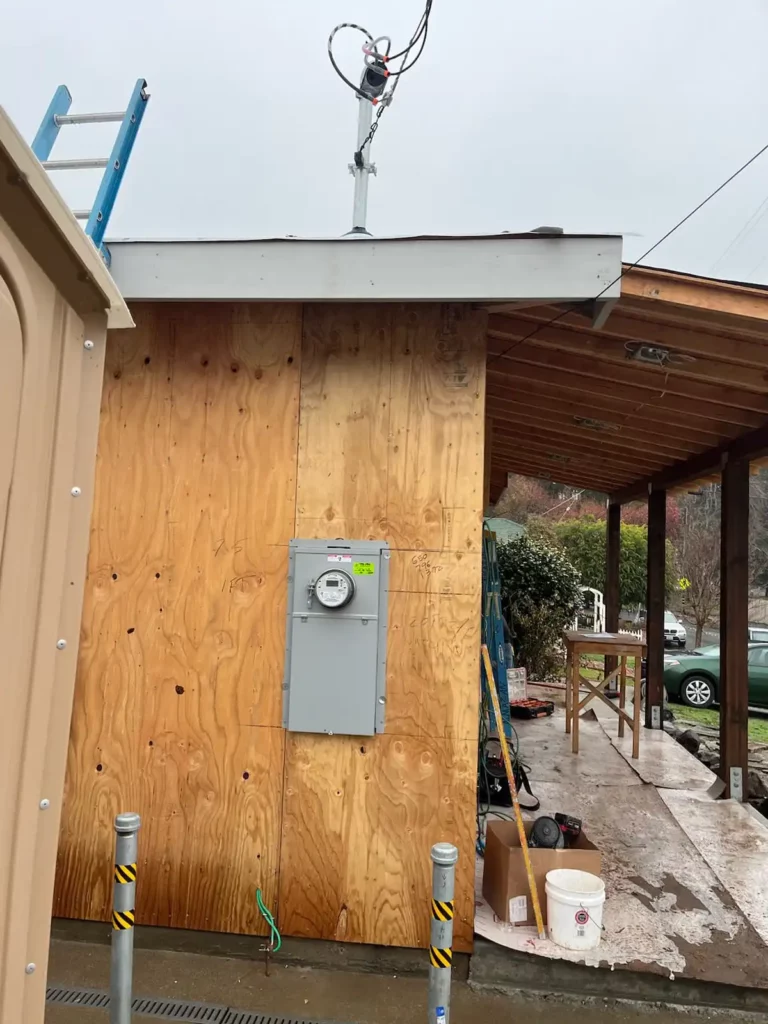Electrical Company – Electric Remodel Rewiring vs New Home Rewiring
When working with an electrical company, remodeling or building a new home, electrical wiring is a major consideration. While both projects require extensive wiring, there are important differences between rewiring an existing structure vs wiring a new build from the ground up. Understanding these key distinctions will help you plan appropriately and ensure all your electrical needs are met. This article outlines the unique challenges, code requirements, costs, and other factors to weigh for each type of residential rewiring project.
Want to learn more about the Role of An Electrical Company? Check out our last blog post HERE!

Outline:
- Evaluating your existing electrical system
- New build wiring benefits and planning
- Code requirements and restrictions for remodels
- Allowances for new construction wiring
- Managing demolition for rewiring projects
- Cost comparisons: new builds vs remodel wiring
- Coordinating electricians for seamless rewiring
- Future-proofing wiring in new homes
- Maximizing energy efficiency in rewires
- Safety considerations for each project type (Reference this blog post on safety!)
Introduction
When planning a home addition, kitchen remodel or other major renovation, rewiring is frequently required to update old, insufficient electrical systems. Alternatively, new home construction allows you to design and install electrical systems from the ground up. The wiring for these two situations has key differences homeowners should understand when working with an electrical company.
Existing homes often have outdated wiring that lacks capacity for modern loads and safety features. Complete rewiring ensures sufficient, up-to-code electrical service. New construction allows customized wiring tailored to your needs, while avoiding restrictions that come with remodeling occupied spaces. Costs also vary dramatically between the two scenarios.
Have A Project In Mind?
Let's Text About Your ProjectHowever, both projects require careful planning and a skilled electrical company. Reviewing the critical contrasts ahead of time will lead to informed decisions and successful electrical work, whether revitalizing wiring in a remodel or building from scratch.
Key Areas of Focus: Safety, Energy Efficiency, Future-Proofing & More
Evaluating Your Existing Electrical System
Before undertaking a remodeling project, have an electrical company thoroughly evaluate your current wiring. This professional inspection serves several purposes:
Determines if existing wires need replacement due to age, insufficient gauge or unsafe materials like aluminum.
Checks if additional circuits are needed to support added appliances, electronics and lighting.
Identifies lack of safety features like AFCI/GFCI breakers and inadequate grounding.
Questions About Our Services?
Let's Connect And DiscussAssesses if electrical panel should be upgraded due to insufficient amps or outdated fuse box.
Looks for hazardous DIY work, unpermitted additions and other issues.
Problems like overloaded circuits, lack of grounding and faulty connections may mandate a full rewire. Cosmetic upgrades like new lighting can often utilize existing wiring if found in good shape. Either way, understanding the limitations of your current electrical system ahead of time prevents surprises down the road.
New Build Wiring Benefits and Planning
New home construction allows you to design a contemporary electrical system tailored to your family’s needs and living patterns. Today’s wiring supports larger appliance loads, electronics-filled rooms and increased lighting flexibility through LED fixtures. An experienced electrical company will know how to effectively and efficiently manage through this process.
Meet with your architect early in the design process to map electrical plans, including:
The number of circuits required for each room based on its usage.
Where to place outlets, switches, lighting fixtures and CATV/data ports.
Capacity needed to support appliances like electric vehicle chargers or tankless water heaters.
Home automation system wiring for smart lighting, A/V, security, etc.
Future expansion capabilities to wire unfinished spaces later on.
New construction allows customizing your home’s wiring to match how you’ll actually live in it. Take advantage of this flexibility to avoid energy-wasting adaptations later.
Get In Touch!
Text Us For A QuoteCode Requirements and Restrictions for Remodels
When remodeling an older home, an electrical company can help you be prepared and expect to discover outdated wiring that no longer meets code. Common deficient areas include:
Insufficient wire gauge to handle added loads.
Lack of grounding to route fault currents safely.
Not enough circuits resulting in frequent tripping as more devices are powered.
Exposed cables and junction boxes, creating fire and electrocution risks.
A licensed electrical company know the National Electrical Code thoroughly and can rewire to bring your home up to its latest standards. However, remodeling also introduces unique challenges:
Wall demolition required for new cable runs and boxes can add costs and extensive repairs.
Working around occupants’ belongings without damage adds difficulty.
Allowed voltage drop percentages may prevent extending existing circuits significantly.
Lack of accessible paths for new wiring through finished walls and ceilings is common.
Questions About A Project?
Let's Connect!Running new wires through finished areas is substantially more labor intensive.
The wiring required for additions and renovations often impacts existing construction due to these factors. Discuss any layout concerns with your electrician to develop solutions.

Allowances for New Construction Wiring
New home wiring avoids many of the limitations and constraints faced in remodeling projects:
Blank slate for routing wires through unfinished walls and ceilings.
No demolition/repairs needed to access wiring paths.
No furnishings or belongings to work carefully around.
Flexibility for ideal outlet, lighting and switch placement.
No voltage drop issues when running new wires from the panel.
Easier to meet code for sufficient circuits and safety devices.
Can oversize wire gauge for increased capacity at marginal extra cost.
More options to separate electrical systems for lighting, HVAC, audiovisual etc.
These advantages allow wiring new construction from a clean slate tailored to your family’s lifestyle. Take advantage by planning ahead wisely.
Managing Demolition for Rewiring Projects
When remodeling an older home, opening up walls and ceilings to access wiring often requires demolition of drywall, plaster or other finishes. This must be done carefully by skilled professionals to protect existing structural elements and properly dispose of debris. Be prepared for:
Potential asbestos or lead risks in older home materials needing abatement.
Extensive dust containment to avoid spreading through home.
Protecting floors and other surfaces from damage.
Shoring up ceiling/wall structures temporarily while access holes are open.
Exact measurements to cut openings for new components.
Patching and repairs to restore surfaces smoothly once wiring is completed.
Schedule demolition in phases to avoid overly disruptive havoc throughout your home. Remain flexible if additional openings become necessary as wiring issues are uncovered.
Cost Comparisons: New Builds vs Remodel Wiring
New construction wiring costs significantly less overall than rewiring existing homes. Cost factors to ask your electrical company about can include:
New Homes
Open access makes installation faster with minimal structural work.
Total cost distributed over entire home build.
Can minimize waste purchasing exact cable and box quantities needed.
Remodels
Demolition and extensive repairs required for wire access.
Confining wiring to remodel areas means fewer cost sharing opportunities.
Unknowns like poor original construction and the need for asbestos remediation can arise.
Working in phases around occupants raises labor hours.
While impossible to generalize exact figures due to variability, remodeling wiring costs around 50% more per square foot on average than new build wiring.
Coordinating An Electrical Company for Seamless Rewiring
Whether remodeling or new construction, involve electricians early in planning and coordinate closely with other trades to prevent conflicts. For remodeling projects:
Have demolition done first so electricians know areas they’ll access for wiring.
Confirm if any wiring will run through new walls/ceilings before framing.
Refrain from drywall/trim work until electrical is totally complete.
For new homes:
Review framing plans to spot any potential wiring route issues.
Clarify scheduling with other trades to avoid site access conflicts.
Coordinate appliance and fixture electrical needs with choices.
Have electricians conduct final walkthrough to test all wiring before inspection.
Proactive communication ensures optimal workflow and no unpleasant electrical surprises.
Future-Proofing Wiring in New Homes – Energy
New construction offers the invaluable opportunity to future-proof electrical systems. Look ahead at emerging trends:
Pre-wire for EV chargers even if not immediately installing.
Run high capacity wiring to support inductive cooktops.
Include smart home wiring hubs and CAT 6 cables.
Install ample above-ceiling conduit paths for easy expansion.
Use adequate panel capacity and breaker spaces for additions down the road.
With some strategic foresight during building, your home’s electrical system can support evolving needs for decades to come.
Maximizing Energy Efficiency in Rewires
When remodeling a home, the necessity to rewire provides a prime chance to enhance energy efficiency:
Replace old appliances with ENERGY STAR models when wiring changes affect them.
Upgrade interior lighting to LED for dramatically lower electricity use.
Install programmable thermostats and HVAC controls to cut waste.
Add zones to air and heating systems to optimize usage patterns.
Improve weatherization with new doors, windows, insulation and air sealing.
Consider solar panels and backup battery systems when rewiring panel.
Pre-wire electric vehicle charging stations.
Energy savings of 20% or more are very achievable when remodeling projects incorporate efficiency measures.
Safety Considerations for Each Project Type
Both remodeling and new construction wiring require stringent safety practices and code compliance. Key elements include:
Remodels
Secure exposed junction boxes and wires overnight to avoid contact.
Contain dust and debris to protect occupants.
Prevent tripping hazards with clearly marked access areas.
Enforce proper protective equipment for workers.
New Homes
Keep wiring safely capped until ready to energize.
Use rigid conduit for temporary overhead feeds during construction.
Don’t begin drywall until electrical inspection passes.
Require hard hats, eye protection and tool guards on site.
A clean, well organized job site is vital, along with strict safety protocol enforcement. Never take shortcuts that could endanger workers or occupants for either project scope.
Conclusion
While new construction wiring and remodeling rewiring serve the same purpose, key differences exist in their project demands. Understanding these contrasts in demolition, access, costs, energy improvements and safety considerations will lead to an electrical system ideally suiting your home’s needs and lifestyle for decades to come.


FAQ - Frequently Asked Questions
What is your company all about?
Our company is a leading provider of energy services, offering reliable and affordable solutions to our customers. We are committed to providing excellent service and helping our customers save money and energy.
How can I pay my bill?
You can pay your bill through various convenient methods. You can pay online through our website, by phone, by mail, or in person at one of our payment centers. We offer different payment options to suit your preferences.
What should I do in case of an outage?
In the event of an outage, please contact us immediately. You can reach our 24/7 customer support line to report the outage and receive updates on the restoration process.
How can I learn more about your service?
If you want to learn more about our business, we have a wealth of resources available on our website. You can explore our services, read about our commitment to sustainable and renewable energy, and find information on our community programs.
Do you have any programs or incentives for customers?
Yes, we offer various programs and incentives to our customers. These programs are designed to help you save money and energy, and they often provide additional benefits such as rebates or discounts. Please check our website or contact our customer support for more information.
What are your plans for the year 2023?
Our plans for the year 2023 include expanding our services, improving our infrastructure, and continuing our commitment to providing reliable energy solutions. We are constantly striving to meet the evolving needs of our customers and communities.
How can I save money and resources?
We provide tips and resources to help you save money and resources. These include energy-saving tips, information on energy-efficient appliances, and programs that offer incentives for reducing energy consumption.
